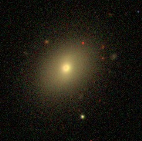Giant Low Surface Brightness Galaxies
Contact

| Dmitry Bizyaev |
|---|
| APO/NMSU |
Summary
This ancillary program aimed to observe giant low surface brightness (GLSB) galaxies similar to Malin 2. These galaxies were identified from the MaNGA target selection catalog as the ones with the largest disk scale length, noticeable bulge and large central velocity dispersion.
Finding Targets
An object whose MANGA_TARGET3 or MNGTARG3 value includes one or more of the bitmasks in the following table was targeted for spectroscopy as part of this ancillary target program. See SDSS bitmasks to learn how to use these values to identify objects in this ancillary target program.
| Program (bit name) | Bit number | Target Description |
|---|---|---|
| GLSB | 25 | Giant low surface brightness galaxies with extended stellar disks and large bulges |
Description
This program aimed to study the formation of giant low surface brightness galaxies (GLSB) with kinematic and abundance information obtained with MaNGA. These rare galaxies have extremely extended disks, to a radius of a hundred kpc (Malin 1, Moore & Parker, 2006). The origin of these galaxies is unclear: while the formation of their low surface brightness disks may require collision perturbation (Mapelli et al. 2008) or accretion of gas-rich dwarf satellites (Penarrubia et al., 2006), the gas disk structure does not necessary require a catastrophic scenario (Kasparova et al., 2014). It is a challenge to make such galaxies in the frames of standard ΛCDM cosmology.
Integral field spectroscopic observations of GLSBs can address the question if kinematic misalignment in the stellar and gas components is a common feature in these galaxies. This would be a strong argument for the minor merging scenario of GLSB galaxy formation, as outlined in Penarrubia et al. (2006).
REFERENCES
Hagen L. M. Z., Seibert, M. , Hagen, A. et al. 2016, ApJ, 826, 210
Kasparova, A., Saburova, A., Katkov, I. et al. 2014, MNRAS, 460, 89
Mapelli M., Moore B., Giordano L., Mayer L., Colpi M., Ripamonti E., Callegari S., 2008a, MNRAS, 383, 230
Moore, L., & Parker, Q. A. 2006, Publ. Astron. Soc. of Australia, 23, 165
Penarrubia, J., McConnachie, A., & Babul, A. 2006, ApJL, 650, L33


